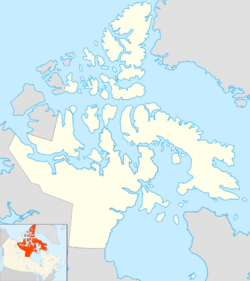Nottingham Island facts for kids

Nottingham Island, Nunavut
|
|
| Geography | |
|---|---|
| Location | Hudson Strait |
| Coordinates | 63°17′N 77°55′W / 63.283°N 77.917°W |
| Area | 1,372 km2 (530 sq mi) |
| Administration | |
| Territory | Nunavut |
| Region | Qikiqtaaluk |
| Demographics | |
| Population | Uninhabited |
Nottingham Island (Inuktitut: Tujjaat) is an island in Nunavut, Canada. It is located in the Hudson Strait, which is a large body of water connecting Hudson Bay to the Atlantic Ocean. The island is not currently home to any people.
Island History
Nottingham Island got its name from the English explorer Henry Hudson. He named it in 1610 during his travels. Many years later, in 1884, a special building called a weather station was built on the island. A weather station helps scientists collect information about the weather, like temperature and wind.
Later, in 1927, an airfield was built on Nottingham Island. An airfield is like a small airport where planes can land and take off. This airfield was important for watching the ice in Hudson Bay. Knowing about the ice helps ships travel safely.
The Inuit people used to live on Nottingham Island. However, in October 1970, they moved away. They went to bigger towns, like Cape Dorset. People often move from small, isolated places to larger towns to find more services and opportunities.
Wildlife on the Island
Nottingham Island is well-known for its large population of walruses. Walruses are big marine mammals with long tusks. They often gather in large groups on the island's shores. The island provides a good habitat for these amazing animals.
See also
 In Spanish: Isla Nottingham para niños
In Spanish: Isla Nottingham para niños



